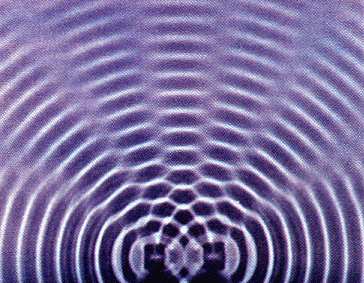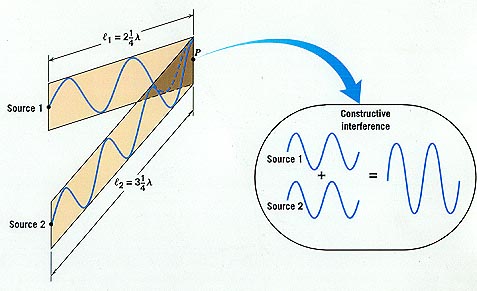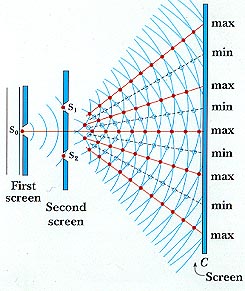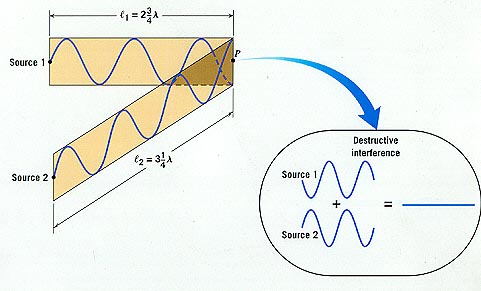Interference with waves
In interference, waves from different sources intersect and make patterns of bright and dark, in the case of light waves, due to the waves canceling each other or reinforcing each other. Water waves interfere to make bands of flat water where waves cancel, next to ridges of increased amplitude where waves reinforce -- as shown below.
Below: A beam goes through two slits as shown and the result when the light reaches a screen is an interference pattern: bands of dark and light. The bright bands are from waves that are "in phase" -- that is, their ups and downs coincide so that they add together, their light energy combines. This is called constructive interference. It is depicted in the graphic below - "figure 58". Wave 1 and wave 2 are show separately, and below them, "total displacement", shows the increased amplitude that results when they combine........The dark bands on the screen occur where the waves are out of phase -- that is the peak (up curve) of one wave coincides with a trough (down curve) of another. They are opposite and they cancel when the waves combine. This is shown in figure 59, wave 1 and wave 2 combine and the result is no wave at all, the flat line on the bottom ("total displacement"). This is called destructive interference. The light waves are still there, in a dark band -- take away one wave and the other appears -- but during destructive interference that energy somehow disappears. There are those who argue that "conservation of energy" is violated when the light disappears. According to the law of conservation of energy, energy cannot vanish, it can only change into another form. The prevailing view is that the light which disappears shows up in the bright bands. (We are looking for a discussion of this phenomenon which describes how the light migrates over to the reinforcing side and which addresses the question of the measurement of the increased brightness due to this added energy in the reinforcing bands.)
| Below: waves 1 and 2 are "in phase" on the left, .... waves 1 and 2 are "out of phase" on the right. When waves are in phase they combine, or "reinforce", when they are out of phase they cancel. When light waves cancel there is darkness. When they reinforce they deliver increased brightness. When water waves cancel the result is a smooth surface. When they reinforce the result is amplified peaks and troughs. | |
|
|
The picture below shows interference with water waves. The water waves do not show their effect on a screen -- they don't make a pattern like the light pattern shown above. We write "dark...bright...dark.." so the analogy between water interference and light interference can be shown. This view of water waves interfering is equivalent to looking at the light experiment, shown above, interference from the side, as depicted in the image.
| dark bright dark bright dark bright dark | |
| The two objects shown as dark rectangles at bottom of the picture are mallets which are tapping the water, making two circular wave patterns, which are shown interfering.. The gray lines radiating out are where the waves are canceling. The water is flat there, as is easy to see in a live demonstration. They are flat lines of canceling waves, or "destructive interference." In the light wave interference picture above, the dark bands are the result of destructive interference. The darkness where the light waves have canceled is equivalent to the flat water where the water waves have cancelled.............Between flat water bands are amplified bands where the waves are reinforcing, resulting in higher peaks and troughs. These bands are the equivalent of the bright bands in the picture above. The two mallets tapping the water give two wave sources just like the double slits above provide two wave sources. |  |
The concepts of interference described above are shown again below with different images.
| Below: waves in phase combine and add to give "constructive interference." | Below: same idea as above: max and min = bright and dark w/light (maximum where waves add and minimum where waves cancel) |
 |
 |
| Below: waves out of phase combine and cancel in "destructive interference." | |
 |